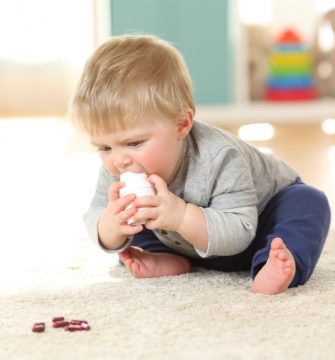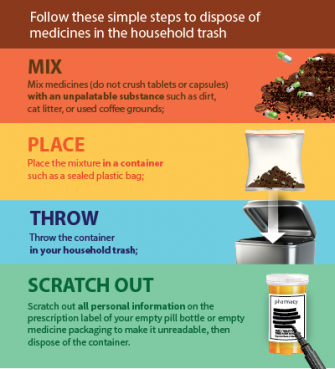Unused Medicines Remain a Risk
 One of the benefits of chiropractic care is that it does not carry the risk of side effects or interactions that result from many prescription medications. Still, there are times when a health condition, illness or injury is such that medications may be required. While medications can provide a benefit when used correctly, they can also pose a risk in the wrong hands.
One of the benefits of chiropractic care is that it does not carry the risk of side effects or interactions that result from many prescription medications. Still, there are times when a health condition, illness or injury is such that medications may be required. While medications can provide a benefit when used correctly, they can also pose a risk in the wrong hands.
- Have you ever filled a prescription, then only consumed a portion of the doses before your symptoms were alleviated and you stopped taking it?
- Do you know how to dispose of the unused medication?
- Do you know the risks associated with keeping medications in the home that are not being used?
Depending on the specific medication, there can be serious and even fatal consequences if not taken as prescribed. Two of the most obvious victims are children and pets. In either case, the risk comes when they are able to handle and or consume medication that they have found. In some situations, even the wrapper can be harmful or deadly.
The FDA reports these staggering statistics:
- Roughly 60,000 ER visits and 450,000 calls to poison control are a response to a child under the age of 6 finding and ingesting medication.
- Over 2/3 of ER visits for pediatric medication exposure involve a child age 2 or younger.
- Nearly 20% of ER visits for pediatric medication exposure result in hospitalization.
- In a study regarding accidental child exposure to a grandparent’s medication, 45% of the cases entailed medication that had been stored in “child-resistant” containers.
- Even “used” fentanyl patches contain enough of the drug to be harmful or even fatal to a child, pet or other individual.
In addition to the accidental consumption by children, unused medication can also become a source of misuse and addiction. In fact, many adolescents and adults who report nonmedical use of opioids say they obtained the drugs from family or friends. This spurned researchers to conduct a national survey to determine the significance of this issue. Their findings were shocking.
- 7% had shared opioid medications with another individual. Of those, 73% said it was to help the person with pain control.
- 7% were still using the opioid medications at the time of the survey.
- Over 50% had, or expected to have, leftover medication. Of those, 61% planned to keep the medication for later use.
- Few said they kept opioid medications inaccessible to others. A minority of the respondents said they keep it “in a locked (8.6%) or latched (20.9%) location.”
How to Dispose of Expired/Unwanted/Unused Medications
If you have medications that are expired or no longer needed, it is important to dispose of them as quickly as possible to avoid them being available for misuse. Medication Take-Back programs are the best way to dispose of unwanted medications.
The US DEA hosts a bi-annual National Prescription Take-Back Event. They partner with local law enforcement, pharmacies and others to provide drop-off locations in communities across country. These events are typically held in April and October. You can learn more about dates and locations here. Additionally, some local agencies may offer periodic take back events in their community. Contact your local law enforcement or waste management authorities to learn about events in your area.
In addition to the periodic take-back events, the DEA has also authorized permanent collection sites in retail pharmacies, hospital or clinic pharmacies, and law enforcement facilities. Some also utilize mail-back programs or drop-boxes. You can locate a DEA-registered collector in your area. You can also call 800-882-9539 to inquire about an authorized collector in your area.
If there is not a take-back program in your area, many medications can be disposed of in the household trash. However, for safety’s sake, do not simply toss the medicine into the trashcan. Instead, first mix the medication with a substance such as dirt, cat litter or used coffee grounds – something a child or animal is less likely to try to touch or eat. Place the mixture in a sealed plastic bag and then toss into the garbage. Don’t forget to mark out all personal information from your medication container labels.
Due to the extreme danger of certain medications such as opioids, the FDA has a list of drugs that should be flushed immediately if a take-back program is not readily available. This prevents them from being misused or accidentally ingested or touched. If you have been given specific directions on disposal of a medication, follow those directions. If not, and the drug is listed below, flush any used or unneeded medicine.
| Active Ingredient | Found in Brand Names |
| Benzhydrocodone/ Acetaminophen |
Apadaz |
| Buprenorphine | Belbuca, Bunavail, Butrans, Suboxone, Subutex, Zubsolv |
| Fentanyl | Abstral, Actiq, Duragesic, Fentora, Onsolis |
| Diazepam | Diastat/Diastat AcuDial rectal gel |
| Hydrocodone | Anexsia, Hysingla ER, Lortab, Norco, Reprexain, Vicodin, Vicoprofen, Zohydro ER |
| Hydromorphone | Dilaudid,Exalgo |
| Meperidine | Demerol |
| Methadone | Dolophine, Methadose |
| Methylphenidate | Daytrana transdermal patch system |
| Morphine | Arymo ER, Embeda, Kadian, Morphabond ER, MS Contin , Avinza |
| Oxycodone | Combunox, Oxaydo (formerly Oxecta), OxyContin, Percocet, Percodan, Roxicet, Roxicodone, Targiniq ER, Xartemis XR, Xtampza ER, Roxybond |
| Oxymorphone | Opana, Opana ER |
| Tapentadol | Nucynta, Nucynta ER |
| Sodium Oxybate | Xyrem oral solution |
Flushing Medications and the Environment
The FDA is aware of concern regarding trace amounts of the medications making their way into the water supply or affecting other aspects of the environment. After evaluating both the environmental and human health risks associated with flushing 15 medicines, they concluded that the risk to the environment is “negligible.”
Further, they believe “that the known risk of harm, including death, to humans from accidental exposure to certain medicines, especially potent opioid medicines, far outweighs any potential risk to humans or the environment from flushing these medicines when a take-back option is not readily available… Still, the FDA recommends that if readily available, consumers first consider disposing of these drugs as quickly as possible through medicine take-back programs or DEA-registered collectors before flushing down the toilet.”
For our body as well as for our environment, natural, non-pharmaceutical health care options are often the best 1st choice. If you do need medications, ensure that you keep them in a safe place, out of the reach of children, pets, or others who may misuse them, and dispose of any unused medication properly when your treatment is complete.
For more information about how chiropractic can help you provide safe, effective treatment for pain without the use of risky opioids, visit www.tnchiro.com/articles/addressing-pain.
For more information about safe disposal of medications in your area, visit https://countitlockitdropit.org/count-lock-drop-miss-tennessee-partner/.
REFERENCES:
Disposal of Unused Medicines: What You Should Know https://www.fda.gov/drugs/resourcesforyou/consumers/buyingusingmedicinesafely/ensuringsafeuseofmedicine/safedisposalofmedicines/ucm186187.htm
Kennedy-Hendricks A, Gielen A, McDonald E, McGinty EE, Shields W, Barry CL. Medication Sharing, Storage, and Disposal Practices for Opioid Medications Among US Adults. JAMA Intern Med. 2016;176(7):1027–1029. doi:10.1001/jamainternmed.2016.2543
Take Back Day. takebackday.dea.gov
